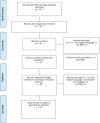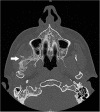Myositis ossificans traumatica of the masticatory muscles: etiology, diagnosis and treatment
- PMID: 30373608
- PMCID: PMC6206835
- DOI: 10.1186/s13005-018-0180-6
Myositis ossificans traumatica of the masticatory muscles: etiology, diagnosis and treatment
Abstract
Background: Myositis ossificans describes a heterotopic bone formation within a muscle. Thereby myositis ossificans is classified in two different groups: myositis ossificans progressiva (MOP) which describes a genetic autosomal dominant rare disease and myositis ossificans traumatica (MOT). The exact pathogenesis of MOT is unclear. The aim of this article was to analyse and interpret the existing literature reporting MOT of masticatory muscles and compare the results with our own clinical experience with MOT. Risk-factors, etiology, clinical features, diagnostic imaging, as well as different treatment options were evaluated and recommendations for the prevention, diagnosis, and therapy of MOT of the masticatory muscles were given.
Methods: Following the PRISMA-Guidelines, a systematic search within the PubMed/Medline database with a view to record literature of MOT of the masticatory muscles was performed. Furthermore, the database of our own clinic was screened for cases of MOT.
Results: In total, 63 cases of MOT of the masticatory muscles which were reported in English-based literature were included in this study. Overall, 25 female and 37 male patients could be analysed whereas one patient's gender was unknown. Complication of wisdom-tooth infection (n = 3) as well as the results of dental procedures like dental extraction (n = 7), mandibular nerve block (n = 4), periodontitis therapy (n = 1) were reported as MOT cases. From the 15 reported cases that appeared after dental treatment like extraction or local anesthesia the medial pterygoid (n = 10) was the most affected muscle. Hereof, females were more affected (n = 9) than males (n = 6). The most reported clinical symptom of MOT was trismus (n = 54), followed by swelling (n = 17) and pain (n = 13). One clinical case provided by the authors was detected.
Conclusions: Dental procedures, such as local anesthesia or extractions, may cause MOT of the masticatory musculature. Demographical analyses demonstrate that females have a higher risk of developing MOT with respect to dental treatment. The most important treatment option is surgical excision. Subsequent physical therapy can have beneficial effects. Nevertheless, a benefit of interpositional materials and drugs as therapy of MOT of the masticatory muscles has not yet been proven. Myositis ossificans progressiva has to be excluded.
Keywords: Heterotropic ossification; Masticatory muscles; Myositis ossificans; Myositis ossificans circumscripta; Myositis ossificans traumatica.
Conflict of interest statement
Ethics approval and consent to participate
The ethical approval for this study was obtained from the ethical review committee (Ref. no. 2017–052-f-N), Ethikkommission der Ärztekammer Westfalen-Lippe und der Westfälischen Wilhelms-Universität, Münster, Germany.Written informed consent was obtained from the patient.
Consent for publication
Written informed consent was obtained from the patient for publication of the case report and any accompanying images. A copy of the written consent is available for review by the Editor-in-Chief of this journal.
Competing interests
The authors declare that they have no competing interests.
Publisher’s Note
Springer Nature remains neutral with regard to jurisdictional claims in published maps and institutional affiliations.
Figures






References
-
- Kaplan FS, Seemann P, Haupt J, Xu M, Lounev VY, Mullins M, Shore EM. Investigations of activated ACVR1/ALK2, a bone morphogenetic protein type I receptor, that causes fibrodysplasia ossificans progressiva. Methods Enzymol. 2010;484:357–373. doi: 10.1016/B978-0-12-381298-8.00018-6. - DOI - PMC - PubMed
-
- Nizel AE, Prigge EK. Trismus due to myositis ossificans traumatica; report of a case. J Oral Surg. 1946;4:93–101. - PubMed
Publication types
MeSH terms
LinkOut - more resources
Full Text Sources

